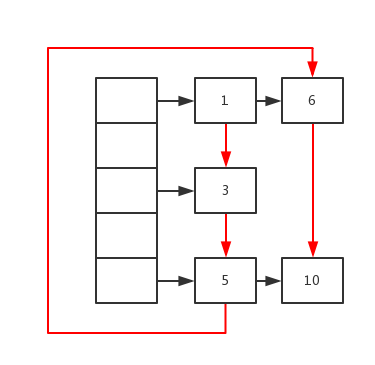一、什么是缓存
这里说的缓存是一种广义的概念,在计算机存储层次结构中,低一层的存储器都可以看做是高一层的缓存。比如Cache是内存的缓存,内存是硬盘的缓存,硬盘是网络的缓存等等。
缓存可以有效地解决存储器性能与容量的这对矛盾,但绝非看上去那么简单。如果缓存算法设计不当,非但不能提高访问速度,反而会使系统变得更慢。
从本质上来说,缓存之所以有效是因为程序和数据的局部性(locality)。程序会按固定的顺序执行,数据会存放在连续的内存空间并反复读写。这些特点使得我们可以缓存那些经常用到的数据,从而提高读写速度。
缓存的大小是固定的,它应该只保存最常被访问的那些数据。然而未来不可预知,我们只能从过去的访问序列做预测,于是就有了各种各样的缓存替换策略。本文介绍一种简单的缓存策略,称为最近最少使用(LRU,Least Recently Used)算法。
二、LRU的实现
我们以内存访问为例解释缓存的工作原理。假设缓存的大小固定,初始状态为空。每发生一次读内存操作,首先查找待读取的数据是否存在于缓存中,若是,则缓存命中,返回数据;若否,则缓存未命中,从内存中读取数据,并把该数据添加到缓存中。向缓存添加数据时,如果缓存已满,则需要删除访问时间最早的那条数据,这种更新缓存的方法就叫做LRU。
实现LRU时,我们需要关注它的读性能和写性能,理想的LRU应该可以在O(1)的时间内读取一条数据或更新一条数据,也就是说读写的时间复杂度都是O(1)。
此时很容易想到使用HashMap,根据数据的键访问数据可以达到O(1)的速度。但是更新缓存的速度却无法达到O(1),因为需要确定哪一条数据的访问时间最早,这需要遍历所有缓存才能找到。
因此,我们需要一种既按访问时间排序,又能在常数时间内随机访问的数据结构。
这可以通过HashMap+双向链表实现。HashMap保证通过key访问数据的时间为O(1),双向链表则按照访问时间的顺序依次穿过每个数据。之所以选择双向链表而不是单链表,是为了可以从中间任意结点修改链表结构,而不必从头结点开始遍历。
如下图所示,黑色部分为HashMap的结构,红色箭头则是双向链表的正向连接(逆向连接未画出)。可以清晰地看到,数据的访问顺序是1->3->5->6->10。我们只需要在每次访问过后改变链表的连接顺序即可。

实现代码如下:
/**
* @author wjg
*
* LRU(Least Recently Used)缓存算法
* 使用HashMap+双向链表,使get和put的时间复杂度达到O(1)。
* 读缓存时从HashMap中查找key,更新缓存时同时更新HashMap和双向链表,双向链表始终按照访问顺序排列。
*
*/
public class LRUCache {
/**
* @param args
* 测试程序,访问顺序为[[1,1],[2,2],[1],[3,3],[2],[4,4],[1],[3],[4]],其中成对的数调用put,单个数调用get。
* get的结果为[1],[-1],[-1],[3],[4],-1表示缓存未命中,其它数字表示命中。
*/
public static void main(String[] args) {
LRUCache cache = new LRUCache(2);
cache.put(1, 1);
cache.put(2, 2);
System.out.println(cache.get(1));
cache.put(3, 3);
System.out.println(cache.get(2));
cache.put(4, 4);
System.out.println(cache.get(1));
System.out.println(cache.get(3));
System.out.println(cache.get(4));
}
// 缓存容量
private final int capacity;
// 用于加速缓存项随机访问性能的HashMap
private HashMap map;
// 双向链表头结点,该侧的缓存项访问时间较早
private Entry head;
// 双向链表尾结点,该侧的缓存项访问时间较新
private Entry tail;
public LRUCache(int capacity) {
this.capacity = capacity;
map = new HashMap((int)(capacity / 0.75 + 1), 0.75f);
head = new Entry(0, 0);
tail = new Entry(0, 0);
head.next = tail;
tail.prev = head;
}
/**
* 从缓存中获取key对应的值,若未命中则返回-1
* @param key 键
* @return key对应的值,若未命中则返回-1
*/
public int get(int key) {
if (map.containsKey(key)) {
Entry entry = map.get(key);
popToTail(entry);
return entry.value;
}
return -1;
}
/**
* 向缓存中插入或更新值
* @param key 待更新的键
* @param value 待更新的值
*/
public void put(int key, int value) {
if (map.containsKey(key)) {
Entry entry = map.get(key);
entry.value = value;
popToTail(entry);
}
else {
Entry newEntry = new Entry(key, value);
if (map.size() >= capacity) {
Entry first = removeFirst();
map.remove(first.key);
}
addToTail(newEntry);
map.put(key, newEntry);
}
}
/**
* 缓存项的包装类,包含键、值、前驱结点、后继结点
* @author wjg
*
*/
class Entry {
int key;
int value;
Entry prev;
Entry next;
Entry(int key, int value) {
this.key = key;
this.value = value;
}
}
// 将entry结点移动到链表末端
private void popToTail(Entry entry) {
Entry prev = entry.prev;
Entry next = entry.next;
prev.next = next;
next.prev = prev;
Entry last = tail.prev;
last.next = entry;
tail.prev = entry;
entry.prev = last;
entry.next = tail;
}
// 移除链表首端的结点
private Entry removeFirst() {
Entry first = head.next;
Entry second = first.next;
head.next = second;
second.prev = head;
return first;
}
// 添加entry结点到链表末端
private void addToTail(Entry entry) {
Entry last = tail.prev;
last.next = entry;
tail.prev = entry;
entry.prev = last;
entry.next = tail;
}
}
每个方法和成员变量前都有中文注释,不必过多解释。
值得一提的是,Java API中其实已经有数据类型提供了我们需要的功能,就是LinkedHashMap这个类。该类内部也是采用HashMap+双向链表实现的。使用这个类实现LRU就简练多了。
/**
*
* 一个更简单实用的LRUCache方案,使用LinkedHashMap即可实现。
* LinkedHashMap提供了按照访问顺序排序的方案,内部也是使用HashMap+双向链表。
* 只需要重写removeEldestEntry方法,当该方法返回true时,LinkedHashMap会删除最旧的结点。
*
* @author wjg
*
*/
public class LRUCacheSimple {
/**
* @param args
*/
public static void main(String[] args) {
LRUCacheSimple cache = new LRUCacheSimple(2);
cache.put(1, 1);
cache.put(2, 2);
System.out.println(cache.get(1));
cache.put(3, 3);
System.out.println(cache.get(2));
cache.put(4, 4);
System.out.println(cache.get(1));
System.out.println(cache.get(3));
System.out.println(cache.get(4));
}
private LinkedHashMap map;
private final int capacity;
public LRUCacheSimple(int capacity) {
this.capacity = capacity;
map = new LinkedHashMap(capacity, 0.75f, true){
protected boolean removeEldestEntry(Map.Entry eldest) {
return size() > capacity;
}
};
}
public int get(int key) {
return map.getOrDefault(key, -1);
}
public void put(int key, int value) {
map.put(key, value);
}
}
只需要覆写LinkedHashMap的removeEldestEntry方法,在缓存已满的情况下返回true,内部就会自动删除最老的元素。
感兴趣的同学可以做一下LeetCode 146. LRU Cache这道题,尝试一下如何实现这个算法。
完整版代码LRUCache.java收录在GitHub仓库Algorithms中,欢迎大家下载试用。
参考资料
Cache replacement policies WikiPedia
146. LRU Cache LeetCode
Laziest implementation: Java’s LinkedHashMap takes care of everything sky-xu